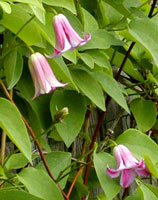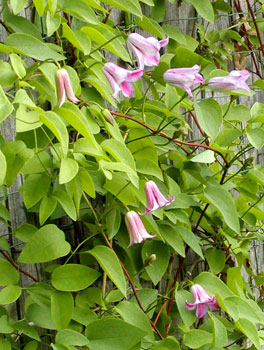Duchess of Albany hybrid clematis
Clematis texensis, 'Duchess of Albany'
... for a non-invasive, blooming, perennial climber

Common name: Duchess of Albany hybrid clematis
Latin Name: Clematis texensis, 'Duchess of Albany'
Design Tip: Grow it where the delicate blooms can be admired at close range, such as over a low shrub by a pathway, or in a trellised patio container. It will climb an althea or dwarf crape myrtle and can color-up spring-bloomers such as forsythia. The delicate simplicity of its flower fits comfortably into a naturalized "edge of the woods" scene.
Form: This herbaceous vine will self-cling to trellis or branches as well as twine, wire or cage fencing attached to walls, wood fences or other flat surfaces.
Size: It is a modest grower compared to the large-flowering types. Yet the height is dependant on the structure it climbs, so that a 10 foot reach can be attained in one Texas growing season.
Flowers: The 1 – 2 inch bell flowers consist of four to six thick, pink petals tinted with a wash of rosy stripes. Bloom begins in late spring, with repeated flushes occurring until first frost.
Foliage: Stems of the leaf fronds wrap themselves around nearby objects.
Soil: A moist well-drained loam is the best medium, but their native heritage allows a wider range, tolerating heavy clay, alkaline earth and brief summer droughts when well established. Clematis, like roses, prosper with supplemental feedings.
Light Exposure: It will live in either full sun or light shade.
Hardiness: This is probably the most heat-tolerant of all hybrid clematis. The roots are cold hardy in USDA Zones 4 – 9.
Grooming: Growth tips of young plants should be gently guided to climb in the desired direction. Mature plants require little or no pruning, but because flowers are produced on new growths, it may become necessary to trim one or two stems close to the ground to induce lower blooming branches. Deadheading in summer instigates faster repeat blooming.
Snippets: British nurseryman Rowland Jackman created Duchess of Albany in 1890 by crossing the native C. texensis species and the hybrid 'Star of India'. Several other varieties have been developed from C. texensis, but this is the most commonly available. The original Texas native species is rarely offered in retail.

Return to Plant Profiles Index
or
Cultivated, photographed and written
by Maggie Ross McNeely in Fort Worth, Texas
All rights reserved